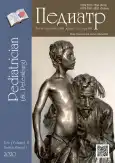Pathogenetic role of changes in the type of blood circulation in the dynamics of brain vascular disorders
- Authors: Nikolaev V.I.1, Denisenko N.P.1, Brega A.V.1, Denisenko M.D.1
-
Affiliations:
- North-Western State Medical University named after I.I. Mechnikov
- Issue: Vol 11, No 1 (2020)
- Pages: 51-57
- Section: Original studies
- URL: https://journal-vniispk.ru/pediatr/article/view/33855
- DOI: https://doi.org/10.17816/PED11151-57
- ID: 33855
Cite item
Abstract
Features of the heart rate variability at patients with acute disorder of cerebral circulation depending on the type of hemodynamics were studied in acute period of disease and in a condition of relative functional rest. Surveyed men and women (121 patients, 30–55 years old) were divided into 3 groups according to the type of hemodynamics that was defined at the first day of their disease: the groups of patients with hyper-, hypo- and normodynamic types of hemodynamics were selected. The integral rheography of the body was carried out again on the 7th day of hospitalization of the patients. And according to the received data all examined individuals were divided into subgroups. The evaluation of indicators of the heart rate variability at patients during acute period of disease showed the significant increase of activity of the sympathetic link of regulation among people with hyperdynamic type of hemodynamics: the indices of tension and vegetative balance also as the standard deviation of NN intervals (SDNN) were rather law. The sam e patients examined on the 7th day of their disease demonstrated the reduction of the indices of tension and vegetative balance and the increase of the mean square difference between the duration of adjacent R-R intervals (RMSSD). These changes were regarded as gradual weakening of the sympathetic influences on cardio-vascular system in stabilization period. At examination of patients in a week from the moment of their hospitalization transformation of the type of hemodynamics was revealed among many of the surveyed. The indices of tension and vegetative balance were the lowest among patients with acute disorder of cerebral circulation and initially hyperdynamic type of hemodynamics and newly formed hypodynamic type of blood circulation. While patients with acute disorder of cerebral circulation and constantly hyperdynamic type of blood circulation showed the maximal tension in operation of the regulatory systems.
Full Text
##article.viewOnOriginalSite##About the authors
Valentin I. Nikolaev
North-Western State Medical University named after I.I. Mechnikov
Author for correspondence.
Email: valentin.nikolaev@szgmu.ru
MD, PhD, Dr Med Sci, Professor, Head, Department of Pathological Physiology
Russian Federation, Saint PetersburgNataliya P. Denisenko
North-Western State Medical University named after I.I. Mechnikov
Email: nataliya_denisen@mail.ru
MD, PhD, Dr Med Sci, Professor, Department of Pathological Physiology
Russian Federation, Saint PetersburgAnastasiya V. Brega
North-Western State Medical University named after I.I. Mechnikov
Email: sonata-luna@mail.ru
MD, PhD, Assistant Professor, Department of Pathological Physiology
Russian Federation, Saint PetersburgMarya D. Denisenko
North-Western State Medical University named after I.I. Mechnikov
Email: maryadenisenko@yandex.ru
MD, PhD, Associate Professor, Department of Pathological Physiology
Russian Federation, Saint PetersburgReferences
- Блеклов С.В., Ярченкова Л.Л., Козлова М.В., и др. Особенности вегетативной регуляции у больных с различными формами ишемического поражения мозга // Бюллетень медицинских интернет-конференций. – 2014. – Т. 4. – № 2. – С. 96. [Bleklov SV, Yarchenkova LL, Kozlova MV, et al. Osobennosti vegetativnoy regulyatsii u bol’nykh s razlichnymi formami ishemicheskogo porazheniya mozga. Bulletin of Medical Internet Conferences. 2014;4(2):96. (In Russ.)]
- Кадыков А.С., Шахпаронова Н.В. Особенности нарушения мозгового кровообращения (инсультов) в молодом возрасте // Новые медицинские технологии. – 2010. – № 4. – С. 11–16. [Kadykov AS, Shakhparonova NV. Features of cerebral circulation (stroke) disorders in young-aged patients. 2010;(4):11-16. (In Russ.)]
- Николаев В.И., Денисенко М.Д., Денисенко Н.П., Исакова А.В. Тип гемодинамики как фактор чувствительности организма человека к эмоциональному стрессу // Вестник Российской военно-медицинской академии. – 2011. – № 2. – С. 164–167. [Nikolaev VI, Denisenko MD., Denisenko NP, Isakova AV. Type of haemodynamics as a factor of sensitivity of an organism to emotional stress. Vestnik Rossiiskoi voenno-meditsinskoi akademii. 2011;(2):164-167. (In Russ.)]
- Николаев В.И., Денисенко Н.П., Денисенко М.Д., Исакова А.В. Роль психофизиологических характеристик человека в развитии эмоционального стресса // Вестник Северо-Западного государственного медицинского университета им. И.И. Мечникова. – 2014. – Т. 6. – № 2. – С. 43–47. [Nikolaev VI, Denisenko NP, Denisenko MD, Isakova AV. Role of human’s psychopysiologic catacteristics in the development of emotional stress. Vestnik Severo-Zapadnogo gosudarstvennogo meditsinskogo universiteta im. I.I. Mechnikova. 2014;6(2):43-47. (In Russ.)]
- Парфенов В.А., Хасанова Д.Р. Ишемический инсульт. – М.: МИА, 2012. – 312 с. [Parfenov VA, Khasanova DR. Ishemicheskiy insul’t. Mоscow: MIA; 2012. 312 p. (In Russ.)]
- Пуршев В.Ю. Цереброваскулярная патология с позиции психосоматической медицины // Медицинский альманах. – 2009. – № 4. – С. 182–185. [Purshev VYu. Cerebrovascular pathology from the position of psychosomatic medicine. Meditsinskiy al’manakh. 2009;(4):182-185. (In Russ.)]
- Binici Z, Mouridsen MR, Kober L, et al. Decreased nighttime heart ratevariability is associated with increased stroke risk. Stroke. 2011;42(11):3196-3201. https://doi.org/10.1161/strokeaha.110.607697.
- Hamer M. Psychosocial stress and cardiovascular disease risk: the role of physical activity. Psychosom Med. 2012;74(9):896-903. https://doi.org/10.1097/psy.0b013e31827457f4.
Supplementary files









